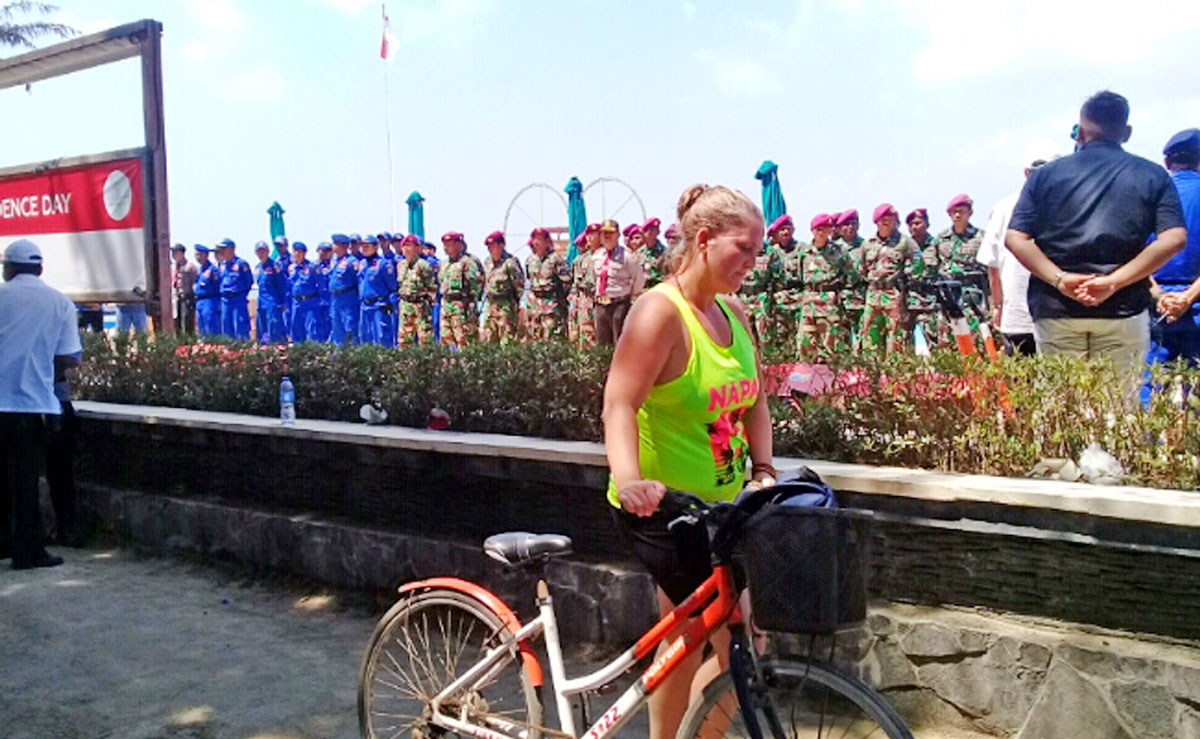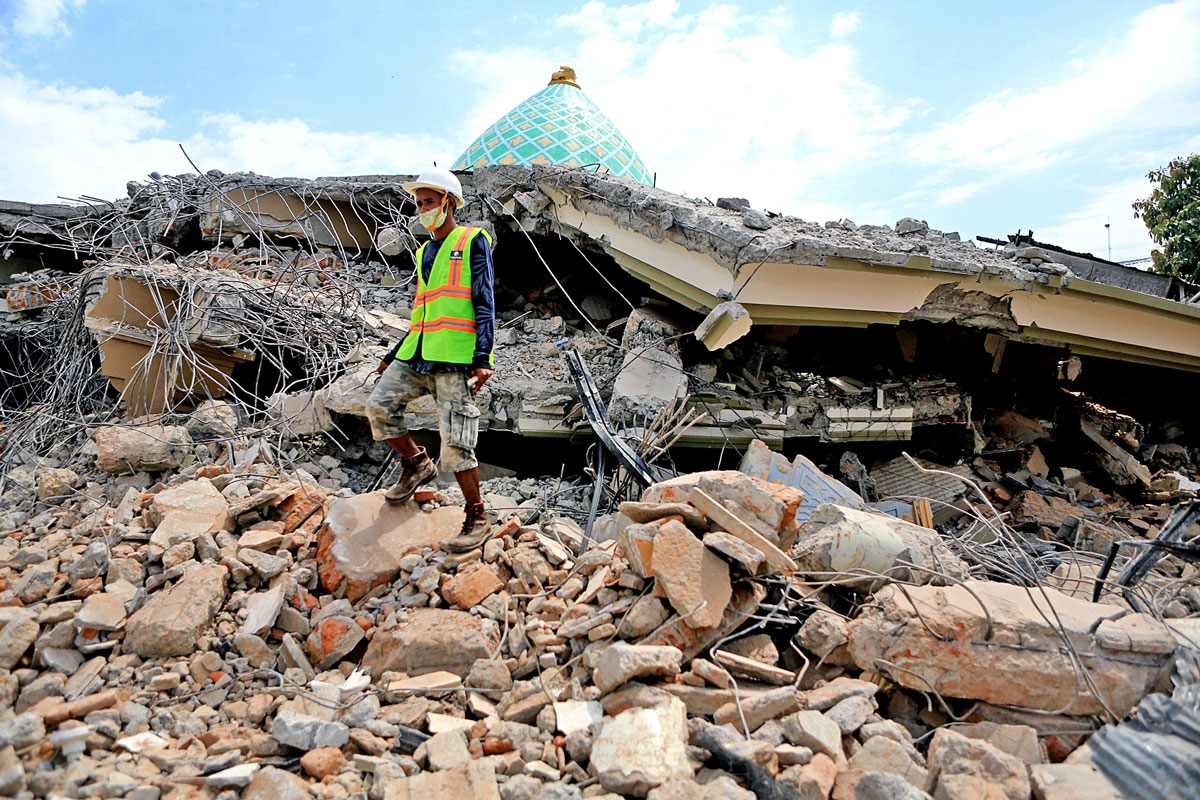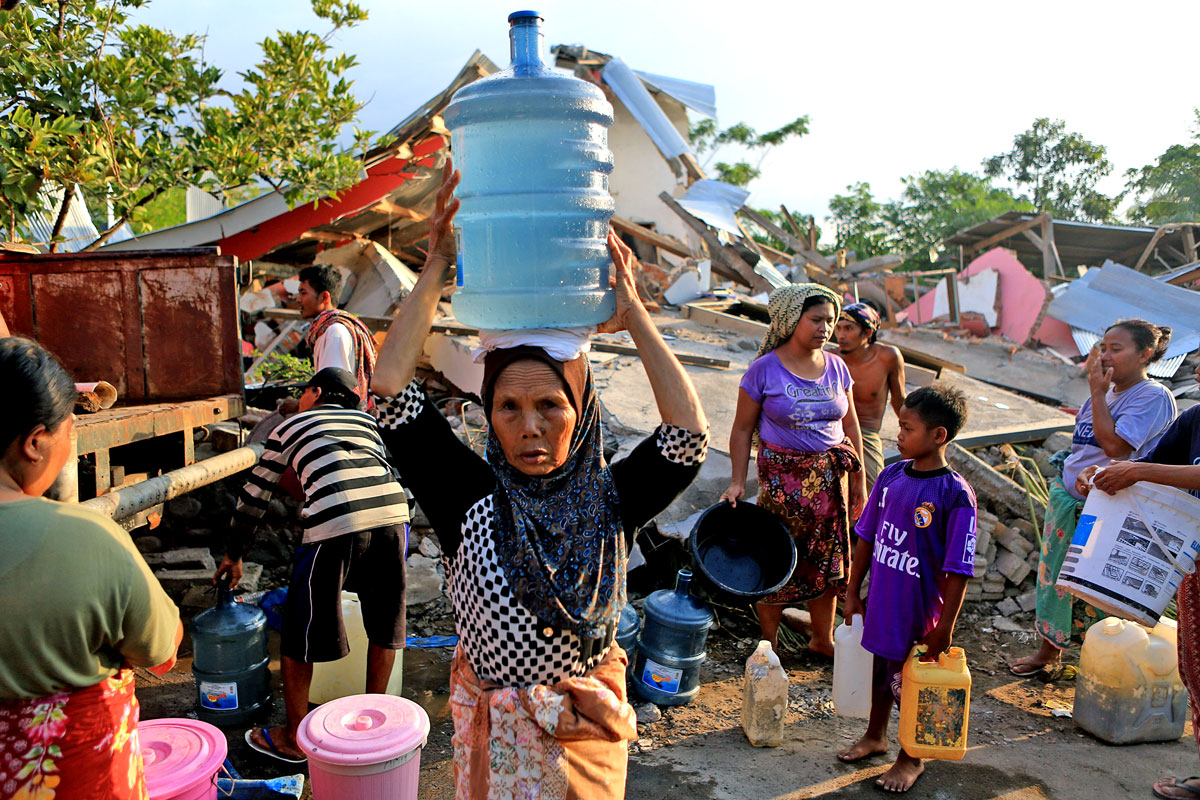Still nursing the wounds from recent devastating quakes, West Nusa Tenggara (NTB) is rebuilding as tens of thousands of traumatized people are still living in shelters. However, it is feared that bureaucratic procedures that go along with the badly needed relief will hamper efforts to help the survivors rise from the rubble, The Jakarta Post correspondent in Mataram Panca Nugraha reports.
The next six months will be a difficult time for NTB, which is trying to get back on its feet after a string of earthquakes wrought havoc on the region, killing more than 500 people, leaving more than 445,000 others homeless and destroying much of its economic infrastructure. The natural disaster inflicted a loss of no less than Rp 7 trillion (US$469.68 million), according to official estimates.
The challenge is especially daunting given the series of quakes — the strongest jolt being 6.9-magnitude — have affected the whole Lombok and nearby lesser islands with varying degrees of severity. Already, wary displaced people who have spent almost two months in shelters decry the government’s promised recon-struction funds that have yet to materialize.
A 2,500-strong joint task force that distributes relief aid, carries out demolition and clears sites before rebuilding work starts. The task force has recorded almost 150,000 damaged houses in Lombok and neighboring West Sumbawa as of mid-September. The destroyed houses, buildings and infrastructure are scattered throughout the 4,725 square kilometer Lombok. The worst hit are west and north Lombok regencies.
The bureaucracy is moving so slowly that only 34,000 of the almost 150,000 damaged houses have been formally verified and confirmed eligible for government aid. About 445,000 victims remain in tents, many of whom fear that the continuing temblors may bring their cracked houses down or that another major quake would strike.
Task force chief Maj. Gen. Madsuni says the existing 48 units of heavy equipment are far from adequate for the enormous endeavor. In the Senggigi tourist area, there is only a single backhoe to do the job in 14 devastated villages. In areas the machine cannot access, officers and villagers do the job manually.
“I have asked the TNI [Indonesian Military] headquarters for at least another 20 units to maximize our work,” he adds.
He estimates site clearing to take three to four months to accomplish. He is shocked at people’s reluctance to lend a hand and tendency to think that it is the military’s and police’s task.
Although the governor officially ended the emergency response period on Sept. 17, the fact that a great number of survivors remain in tents shows that emergency measures are still badly needed. In West Lombok, for instance, the regency government continues providing relief aid to 116,000 victims still living in makeshift shelters.
In West Lombok, where 55,500 houses are damaged, 9,500 severely, even people whose houses sustained only minor damage opted to move to shelters over fears of new tremors.
“People began to return home after the main quake shook but they came back again after the continual temblors that followed. We can’t forbid people from feeling afraid, can we?” says West Lombok Regent Fauzan Khalid.
Uncertainty
The government has set financial assistance at Rp 50 million, Rp 25 million and Rp 10 million for every house that is seriously, moderately and lightly damaged, respectively, as President Joko “Jokowi” Widodo promised when visiting Lombok in July.
On his third visit after the disaster, the President in early September symbolically delivered Rp 50 million to each of the 5,300 victims throughout Lombok. The aid was in the form of saving accounts and the money is meant to build quake-resistant houses with the government helping with the designs.
But to the residents’ dismay, the funds cannot be disbursed. Angry North Lombok residents took to the street on Wednesday to protest the complicated bureaucracy involved in claiming the promised aid.
Syaiful Nuryadi, a village chief in East Lombok, is one of those anxious about the undisbursable funds.
“None of the 88 families who received the savings can withdraw their money,” he says.
In order to be able to withdraw the money from state bank BRI, recipients are required to follow a guideline is-sued by the National Disaster Mitigation Agency (BNPB). A prerequisite requires them to form groups of 20 people comprising recipients, a facilitator and a representative from the Public Works and Housing Ministry.
In East Lombok, the devastated Obelobel subdistrict has been cleared of rubble, but people are still unable to begin rebuilding their houses because relief funds cannot be disbursed. Until then, they will have to stay in tents.
A sense of uncertainty caused by undisbursable relief funds is also gripping quake survivors in West Lombok. Like in the north, patience is wearing thin here.
“Damage to our houses has been surveyed, yet there is no news as to when the promised funds will be delivered,” says Nur Aisyah, 55, a resident of Bengkaung village.
The house she had built in 2003 after seven years of hard work as a maid in Saudi Arabia was leveled to the ground. Now, she lives in a tent erected in her backyard. Adding insult to injuries, she has lost her job as a domestic helper because her traumatized employer returned to Java, probably for good.
But Muhammad Rum, the NTB Disaster Mitigation Agency (BPBD) chief, has a different story about the funds. He acknowledges that the disbursement process was delayed, pending implementation directives for the BNPB guideline.
The directives were already issued on Sept. 12 and, he maintains, people should have no problem withdrawing their money as long as they have formed the 20-member community groups as required. The provincial government has allocated Rp 528 billion for the first batch of 5,300 entitled victims.
In reality, however, the bureaucracy is much more arduous than residents may have thought. Rum says the aid is not provided in cash to each family, but the money will be transferred to the groups’ bank accounts by the regency or city government. To minimize the chances of corruption, no cash transaction is allowed. Payments for building materials will be deducted from the collective savings.
Transitional houses
Disappointed by the complicated bureaucracy and scared by the impending rainy season, some survivors have asked authorities to build them “transitional houses” that would give them wider elbow room and more hygienic shelters while waiting for permanent houses to be rebuilt with government aid.
The request has found a sympathetic ear from the West Lombok regent and the BPBD, who granted it. Worst affected areas like Guntur Macan village in West Lombok, where almost all of the 2,500 houses were destroyed and 6,000 people displaced, will receive priority.
“We have been in shelters for almost two months and can’t imagine how the situation would deteriorate when the rain falls. We’re in dire need of transitional houses to move in while waiting for the Rp 50 million [government aid],” says Guntur Macan village chief Muhammad Murni.
Most of the displaced villagers are living in tents erected on soccer fields and fallow paddy fields. They have no problems with food and clothing as donations are still coming in. West Lombok has the highest number of displaced people at 116,500. More than 55,000 houses were damaged. The displacement has unexpectedly triggered cases of malaria in the area.
Regent Fauzan believes that West Lombok would need about 8,000 transitional houses that require no less than Rp 15 billion to build.
The disaster has taken the regency by storm. Every year, the local government allocates only Rp 1 billion for disaster mitigation, assuming that the regular threats are floods and drought, which require less money to manage.
“Usually, Rp 1 billion will do. But this quake […] is way beyond our capacity,” Fauzan says.
The local government estimates that Lombok needs 80,000 transitional houses that will take six months to build if everything goes as planned. Because projects are not covered by the central government’s aid, the provincial government is turning to state-owned enterprises and private organizations for help.
Last week, 12 state companies already pledged assistance to building 1,500 houses for 12,000 displaced people. Each of the houses will be 25 square meters in size, have plywood or plaited bamboo walls and zinc roofs. Each building will be big enough for two families to share.
Also lending a hand are Islamic organizations Nahdlatul Ulama (NU), Indonesia’s largest Islamic organization, Rumah Zakat and volunteers grouped in Quick Response Action, which pledged to build 1,000 transitional houses each.
Baiq Diyah Ratu Ganefi, a member of the House of Representatives from Lombok and chairwoman of the Lombok Association of Businesswomen, question the central government’s failure to include the provision of transitional houses despite the tight conditions it attaches on its aid for survivors.
What the government needs to do is to accelerate the rebuilding program because the longer survivors spend in shelters, the more problems will occur.
“If the government is serious about helping victims,” she says, “the bureaucratic procedure should be made simple. President Jokowi’s instruction is simple, but why are local bureaucrats making things complicated? Have pity on the survivors.”
Fun seekers trickle back to Lombok as tremors cease
When a 6.4-magnitude earthquake shook Lombok on July 29, the island resort east of Bali bemoaned the abrupt departure of visitors, and when another more terrifying 7.0-magnitude quake struck on the night of Aug. 5, Lombok saw off 4,000 tourists the next day from Gili Islands alone.
Tourism is the beautiful island’s economic backbone, along with agriculture. Its proximity to the famed Bali is undoubtedly an advantage. Its beautiful beaches facing the Indian Ocean, its mountains and lush green land-scapes are comparable to those of neighboring Bali.
Last year, 3.5 million people visited Lombok. Buoyed by the relatively high arrival rate, the island raised its target to 4 million tourist arrivals for this year. But the deadly quakes have undermined its confidence in achieving the target.
The evacuation of panicky tourists, mostly foreign nationals, from Gili Trawangan was an eye-watering scene. When the big quake struck, they were scared of the prospect of a tsunami. They were ferried off to Bali and Central Lombok, which had been relatively unaffected by the disaster.
 Nothing to fear: A tourist passes security officers on Gili Trawangan Island, one of Lombok’s increasingly popular tourist destinations. Recent major quakes have dealt a heavy blow to tourism in West Nusa Tenggara. (JP/Seto Wardhana)
Nothing to fear: A tourist passes security officers on Gili Trawangan Island, one of Lombok’s increasingly popular tourist destinations. Recent major quakes have dealt a heavy blow to tourism in West Nusa Tenggara. (JP/Seto Wardhana)
Gili Trawangan, Gili Meno and Gili Air, sandwiched between northern Bali and Lombok, have become increasingly popular destinations. The immediate impact of the quakes was that 117 of the 194 hotels and restaurants in Senggigi in West Lombok suspended operations.
Addressing displaced people in north Lombok, the then-governor of West Nusa Tenggara (NTB), Muhammad “TGB” Zainul Majdi, tried to lift their spirits with a battle cry of “Rise up NTB”. On Gili Trawangan, the regional police staged an Independence Day celebration at sea on Aug. 17 to show the world that the area was not as scary as people may have thought.
But unfortunately, a 6.9-magnitude shook the region again on Aug. 19, scaring potential visitors farther away.
Today, tourists have begun to come back to Lombok. More events have been staged to convince people it is safe to visit the island. Tourism Minister Arief Yahya is optimistic tourism will recover in six months provided that promotional activities continue.
When visiting Gili Trawangan in mid-September, he recalled how Bali had struggled in the wake of the Mount Agung eruption, which dealt a heavy blow to tourism in Bali that lasted three months.
“Many people [in the hospitality industry] lost their jobs and tourism operators were on the brink of bankruptcy as a result of the falling tourist arrivals. So we [in Lombok] have to do something to keep business alive.”
Other top bureaucrats from Jakarta have been hands-on, too. Coordinating Maritime Affairs Minister Luhut Pandjaitan, Transportation Minister Budi Karya Sumadi and _Yahya were in Sumbawa on Sept. 9 to kick off the Sail Moyo Tambora festival in an effort to revive tourism. The 10-day event featured 140 yachts from 49 countries.
Senggigi, Lombok’s best-known beach, has come to life again with cultural festivals lately. Last week, the West Lombok Tourism Agency held a jazz festival and is planning an international marathon in November.
To shore up the industry in Lombok, the central government has set aside Rp 20 billion (US$1.34 million). The money will be spent mostly on promotion and branding campaigns. Local officials say people are not coming yet because they think that all of Lombok was devastated, which they may have wrongly interpreted from TV foot-age on the quakes.
The truth is that many popular destinations were unaffected and are perfectly safe to visit. Kuta Beach in Mandalika, Central Lombok, is one of the intact attractions. Among the most severely affected were the famous Senggigi Beach in West Lombok and the Mount Rinjani area.
“Tourists are coming back to Gili Trawangan, where hotels and restaurants have reopened. We’re upbeat we can recover in no time,” NTB Tourism Agency chief Lalu Mohammad Faozal said.
People in the hospitality industry are back in business and they need the government’s help to convince the world that tourism in Lombok is returning to normal.
 Decimated: A rescue worker searches for victims that may be buried under the rubble of a collapsed mosque
Decimated: A rescue worker searches for victims that may be buried under the rubble of a collapsed mosque
in Pamenang, North Lombok, after a 7.0-magnitude quake struck in August. (JP/Seto Wardhana)
| Writer | : | Panca Nugraha |
| Managing Editor | : | Primastuti Handayani |
| Desk Editors | : | Pandaya, Imanuddin Razak |
| Art & Graphic Design Head | : | Budhi Button |
| Photographer | : | Seto Wardhana |
| Technology | : | Mustopa, Sandy Riady Hasan, Adri Putranto |
| Multimedia | : | Bayu Widhiatmoko |


